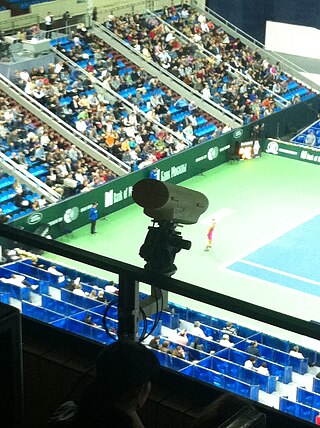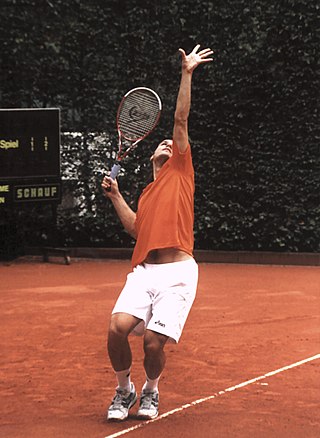
A pointing device is a human interface device that allows a user to input spatial data to a computer. CAD systems and graphical user interfaces (GUI) allow the user to control and provide data to the computer using physical gestures by moving a hand-held mouse or similar device across the surface of the physical desktop and activating switches on the mouse. Movements of the pointing device are echoed on the screen by movements of the pointer and other visual changes. Common gestures are point and click and drag and drop.

Tennis is a racket sport that is played either individually against a single opponent (singles) or between two teams of two players each (doubles). Each player uses a tennis racket that is strung with cord to strike a hollow rubber ball covered with felt over or around a net and into the opponent's court. The object of the game is to manoeuvre the ball in such a way that the opponent is not able to play a valid return. The player who is unable to return the ball validly will not gain a point, while the opposite player will.

A time-domain reflectometer (TDR) is an electronic instrument used to determine the characteristics of electrical lines by observing reflected pulses.
The US Open Tennis Championships, commonly called the US Open, is a hardcourt tennis tournament held annually in Queens, New York. Since 1987, the US Open has been chronologically the fourth and final Grand Slam tournament of the year. The other three, in chronological order, are the Australian Open, French Open and Wimbledon. The US Open starts on the last Monday of August and continues for two weeks, with the middle weekend coinciding with the US Labor Day holiday. The tournament is one of the oldest tennis championships in the world, originally known as the U.S. National Championship, for which men's singles and men's doubles were first played in August 1881. It is the only Grand Slam that was not affected by cancellation due to World War I and World War II, nor interrupted by the COVID-19 pandemic in 2020. All the players participating should be at least fourteen (14) years old.

Hawk-Eye is a computer vision system used in numerous sports such as cricket, tennis, Gaelic football, badminton, hurling, rugby union, association football and volleyball, to visually track the trajectory of the ball and display a profile of its statistically most likely path as a moving image. The onscreen representation of the trajectory results is called Shot Spot.

The ATP Finals is the season-ending championship of the ATP Tour. It is the most significant tennis event in the men's annual calendar after the four majors, as it features the top eight singles players and top eight doubles teams based on their results throughout the season. The eighth spot is reserved, if needed, for a player or team who won a major in the current year and is ranked from ninth to twentieth.
Instant replay or action replay is a video reproduction of something that recently occurred which was both shot and broadcast live.

An electronic component is any basic discrete electronic device or physical entity part of an electronic system used to affect electrons or their associated fields. Electronic components are mostly industrial products, available in a singular form and are not to be confused with electrical elements, which are conceptual abstractions representing idealized electronic components and elements. A datasheet for an electronic component is a technical document that provides detailed information about the component's specifications, characteristics, and performance.
A point in tennis is the smallest subdivision of the match. A point can consist of a double fault by the server, in which case the point is automatically won by the receiver. In all other cases, a point begins when a legal serve is hit by the server to the receiver on the opposite side of the court, and continues until one side fails to legally return the ball to the opposite side. Whichever side fails to do so loses the point and their opponent wins it.
This page is a glossary of tennis terminology.

Ball badminton is a sport native to India. It is a racket sport game, played with a yellow ball made of wool, on a court of fixed dimensions divided by a net. The game was played as early as 1856 by the royal family in Tanjore, the capital of Thanjavur district in Tamil Nadu, India. It enjoys the greatest popularity in India. Ball badminton is a fast-paced game; it demands skill, quick reflexes, good judgment, agility, and the ability to control the ball with one's wrist.
Cyclops is a computer system co-invented by Bill Carlton of Great Britain and Margaret Parnis England of Malta, which is used on the ATP and WTA professional tennis tours as an electronic line judge to help determine whether a serve is in or out.

An image sensor or imager is a sensor that detects and conveys information used to form an image. It does so by converting the variable attenuation of light waves into signals, small bursts of current that convey the information. The waves can be light or other electromagnetic radiation. Image sensors are used in electronic imaging devices of both analog and digital types, which include digital cameras, camera modules, camera phones, optical mouse devices, medical imaging equipment, night vision equipment such as thermal imaging devices, radar, sonar, and others. As technology changes, electronic and digital imaging tends to replace chemical and analog imaging.

In tennis, an official is a person who ensures that a match or tournament is conducted according to the International Tennis Federation Rules of Tennis and other competition regulations.

In computing, an input device is a piece of equipment used to provide data and control signals to an information processing system, such as a computer or information appliance. Examples of input devices include keyboards, computer mice, scanners, cameras, joysticks, and microphones.
The following outline is provided as an overview of and topical guide to tennis.

A serve in tennis is a shot to start a point. A player will hit the ball with a racquet so it will fall into the diagonally opposite service box without being stopped by the net. Normally players begin a serve by tossing the ball into the air and hitting it. The ball can only touch the net on a return and will be considered good if it falls on the opposite side. If the ball contacts the net on the serve but then proceeds to the proper service box, it is called a let; this is not a legal serve in the major tours although it is also not a fault. Players normally serve overhead; however serving underhand is allowed. The serve is the only shot a player can take their time to set up instead of having to react to an opponent's shot; however, as of 2012, there is a 25-second limit to be allowed between points.
The Next Generation ATP Finals is an annual men's professional exhibition tennis tournament organized by the Association of Tennis Professionals (ATP) for the best players of the season aged 20 years old or younger. The event debuted in 2017 at the PalaLido in Milan, where it was also staged for the next four editions, before it was moved to King Abdullah Sports City in Jeddah, beginning in 2023. From 2017 to 2023 the age threshold was 21 years and under.
Chung Hyeon defeated Andrey Rublev in the final, 3–4(5–7), 4–3(7–2), 4–2, 4–2 to capture the 2017 Next Generation ATP Finals title.
This glossary provides definitions and context for terminology related to, and jargon specific to, the sport of pickleball. Words or phrases in italics can be found on the list in their respective alphabetic sections.












